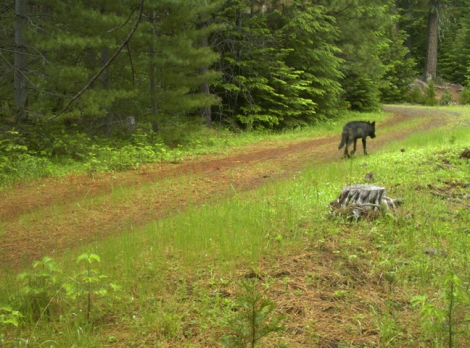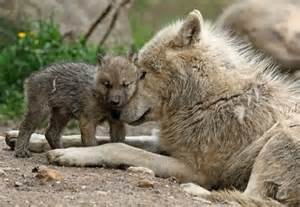In 2005 Wisconsin wanted a permit to kill 43 endangered gray wolves. So the federal government granted it. The way it saw things, controlling wolves—which had earned a bad name by preying on livestock and pets—would increase human tolerance for the predators. By letting the state cull them, it would prevent even more wolves from getting shot by frustrated ranchers.
Nonetheless, this argument—that legal killing helps stop illegal killing—continues to be made around the world. The United States still asserts it when it comes to grizzly bears. Both Sweden and Finland use it as a justification for controlled wolf hunting. “The philosophy that underpins wolf management is that hunting them makes them more socially acceptable to people,” says Doug Smith, senior wildlife biologist at Yellowstone National Park.
But now a new study examining wolf population growth rates in Michigan and Wisconsin shows that the opposite is true. Government-sanctioned culling actually results in more illegal killings, scientists report this week in the journal Proceedings Royal Society B.
They created this animated video to help break down the results:
“The idea that we need to kill to conserve large carnivores—in light of our study, it does not make sense,” says author Guillaume Chapron, an ecologist at the Swedish University of Agricultural Sciences, who teamed up with Adrian Treves, a conservation biologist at the University of Wisconsin, Madison, to research the topic.
The research will likely inflame the hotly contested debate that has long pitted conservationists and biologists against agricultural and hunting interests. “I suspect there’s going to be a lot of folks weighing in on this from both sides,” says Jason Fisher, a wildlife scientist with Alberta Innovates, a research agency for the government of Alberta, Canada.
Gray wolves were viewed as so destructive to livestock that by the early 20th century they’d nearly been wiped out in most of the U.S. In 1978 the U.S. listed them as endangered in all states but Minnesota. Reintroduced to the American West in the mid-1990s, they’ve been the object of fierce controversy ever since.
In 2003 the U.S. declared that some populations had recovered to the point that wolves could be considered threatened rather than endangered. This meant states would be permitted to trap and shoot wolves when they threatened humans or livestock.
But with disagreements continuing about their recovery status, the issue has bounced in and out of court. Today the species is considered endangered in most states, but in Montana and Idaho wolves can be culled and hunted. And other states can cull them in certain cases.
Does Culling Conserve a Species?
Between 1995 and 2012, wolves in Michigan and Wisconsin experienced six periods of legal culls and six stages of protection, making these states ripe for testing whether cullings help conserve large carnivores.
To test the theory, researchers Chapron and Treves used a complex algorithm to measure population growth over time, taking into account the number of wolves culled. They found that during years when culling was allowed, there was an overwhelming probability that the wolf growth rate would drop.
The researchers concluded that poaching was the only plausible explanation for the decline. They ruled out other potential factors such as wolves migrating out of state and a slowdown in reproductive rates.
So why would people get poaching fever during years that the government OKs wolf culling? It could be that people didn’t think wolves had much value or they felt the government wouldn’t enforce the law during years culling was allowed, the researchers say. Their findings corroborate a 2013 study showing that legal culls don’t reduce the inclination to poach.
Chapron and Treves hope their study will show wildlife management agencies that they need to produce evidence before justifying “leniency in environmental protections,” as they put it. Fisher agrees. “The paper showed very clearly that wolf populations are experiencing added deaths” he says. “Governments all over need a lot more and a lot better information than they currently have about wildlife populations.”
Yellowstone’s Smith says the results are disappointing in that they throw into question long-held beliefs about wolf management. “But I’m not convinced,” he says.
Smith doesn’t think the results should apply to all wolf territories, as attitudes toward wolves might be different in areas where people have always lived alongside the animals, such as Alaska and Canada. Nor is he fully persuaded that poaching accounted for the population growth decline, though he doesn’t question the researchers’ data. Indeed, another study found that less government involvement resulted in decreased poaching.
But the current study could provide more grist for pro-wolf groups who have criticized wildlife management agencies for basing decisions on politics rather than science. Wildlife Services, a program of the U.S. Department of Agriculture that specializes in killing predators that put livestock at risk, in particular has faced criticism that its lethal control programs are not based on sound science.
And research from 2014 found that killing wolves to protect sheep and cattle actually caused the predators to kill even more livestock, contrary to a common justification for culling some large carnivores.
Chapron and Treves think their research should help guide management decisions for many large carnivores, such as grizzly bears, which could soon lose protections under U.S. law. In the meantime, the debate swirling around wolves will likely continue. “The study is going to be hugely controversial,” Fisher says.
This story was produced by National Geographic’s Special Investigations Unit, which focuses on wildlife crime and is made possible by grants from the BAND Foundation, and the Woodtiger Fund. Read more stories from the SIU on Wildlife Watch. Send tips, feedback, and story ideas to ngwildlife@ngs.org.
===
Posted in: gray wolves, Wolf Wars, Wolf Poaching
Photo: Courtesy Tim Fitzharris, Minden Pictures/National Geographic
Tags: evils of wolf hunting, killing wolves, poaching, culling National Geographic, blood does not buy goodwill























 Boulder White Clouds Council
Boulder White Clouds Council Exposing The Big Game
Exposing The Big Game Footloose Montana
Footloose Montana Friends of the Clearwater
Friends of the Clearwater Lockwood Animal Rescue Center
Lockwood Animal Rescue Center Louise du Toit
Louise du Toit LUPUSLAETUS
LUPUSLAETUS Mercy For Animals
Mercy For Animals Northern Idaho Wolf Alliance (NIWA)
Northern Idaho Wolf Alliance (NIWA) Predator Friendly®- Because Wildlife Matters
Predator Friendly®- Because Wildlife Matters Project Coyote
Project Coyote Project: Wolf
Project: Wolf The Nature Conservancy
The Nature Conservancy The Ravensong Group
The Ravensong Group WildEarth Guardians
WildEarth Guardians Wisconsin Wildlife Ethic-Vote Our Wildlife
Wisconsin Wildlife Ethic-Vote Our Wildlife Wolf And Wildlife Studies: Jay Mallonee (Independent Wolf Biologist)
Wolf And Wildlife Studies: Jay Mallonee (Independent Wolf Biologist) Wolf Song of Alaska
Wolf Song of Alaska Wolves in english ! Les loups en anglais !
Wolves in english ! Les loups en anglais ! WWP's Gray Wolf Page
WWP's Gray Wolf Page Yellowstone To Yukon Conservation Initiative
Yellowstone To Yukon Conservation Initiative